常考的动词宾语宾补结构
- 格式:docx
- 大小:22.81 KB
- 文档页数:8

一、“ make宾语+xx”的用法“ make宾语+宾补”这一结构中,宾语补足语可以由名词、形容词、过去分词、不定式等来充当,例如:(1) A good friend is someone who makes you happy(. 形容词作宾补)(2) They made me repeat the story.(省to 的动词不定式)(3) He raised his voice to make himself heard过去分词作宾补)注:“ make宾语+宾补”结构中不用现在分词充当宾补。
(4) We made him monitor of our class.(名词作宾补)注:职务名词充当xx 补时其前面不要加冠词。
【试题链接】1. He is very popular among his students as he always tries to make them___ in his lectures.A.interestedB.interestingC.interestD.to interest2. Myparentshavealwaysmademe___aboutmyself,evenwhenIwastwelve.A.feeling wellB.feeling goodC.feel wellD.feel good答案:1. A2. D二、“ with宾语+xx”的用法“ with宾语+ 宾补”是高考试题中考查十分频繁的结构,“ with宾语+宾补”结构中的宾补主要有形容词、现在分词、过去分词、动词不定式等,在考题中常要求选择宾补的形式,在选择时宾补空间该使用什么形式,主要限决于宾语与宾补的关系,主动关系用现在分词,被动关系则用过去分词,此外,不定式作宾补要表示含义为将来的意味,例如:(2) With everything he need to buy, he went into the store. (不定式作宾补表示将来的含义)(3) With everything he need bought, he left the store. (过去分词作宾补表被动表完成)(4) With my key lost, I couldn ' t ente过m分词作宾补)(5) With nothing to do, I went out for a walk. (不定式作宾补)(6) I went out with the window open. ( 形容词作宾补)另外,“ with宾语+宾补”结构中还可由介词短语、副词短语来充当宾补,如:(1) She said good-bye with tears in her eyes.(2) He left the room with the light still on.试题链接】1. -- C ome on, please give me some ideas about the project. --- Sorry. With somuch work ___ my mind, I almost break down.A.filledB.fillingC.to fillD.being filled2. John received an invitation to dinner, and with his work ___ hegladly accepted it.A.finishedB.finishingC.having finishedD.was finished3. I couldn ' t to my homework with all the noise___.A.going onB.goes onC.went onD.to go on答案:1. B2. A3. A三、“ have宾语+xx”的用法在“have宾语+宾补”这一结构用法中,充当宾补的常用的有do, doing,done和adj,例如:(1) III have my hair cut this after n 我0今天下午要理发(2) I won ' t have you saying to your mother that way.(3) He reaIized that she did not wish to have her go with him.(4) I expect Amy wiII have the tea ready directIy.、/■ I ■ '。
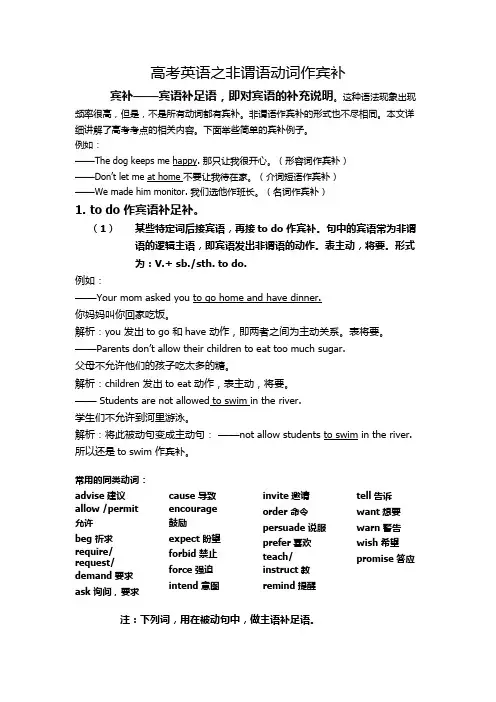
高考英语之非谓语动词作宾补宾补——宾语补足语,即对宾语的补充说明。
这种语法现象出现频率很高,但是,不是所有动词都有宾补。
非谓语作宾补的形式也不尽相同。
本文详细讲解了高考考点的相关内容。
下面举些简单的宾补例子。
例如:——The dog keeps me happy. 那只让我很开心。
(形容词作宾补)——Don’t let me at home 不要让我待在家。
(介词短语作宾补)——We made him monitor. 我们选他作班长。
(名词作宾补)1.to do 作宾语补足补。
(1)某些特定词后接宾语,再接to do 作宾补。
句中的宾语常为非谓语的逻辑主语,即宾语发出非谓语的动作。
表主动,将要。
形式为:V.+ sb./sth. to do.例如:——Your mom asked you to go home and have dinner.你妈妈叫你回家吃饭。
解析:you 发出to go 和have 动作,即两者之间为主动关系。
表将要。
——Parents don’t allow their children to eat too much sugar.父母不允许他们的孩子吃太多的糖。
解析:children 发出to eat 动作,表主动,将要。
—— Students are not allowed to swim in the river.学生们不允许到河里游泳。
解析:将此被动句变成主动句:——not allow students to swim in the river. 所以还是to swim 作宾补。
常用的同类动词:advise 建议allow /permit 允许beg 祈求require/ request/demand 要求ask 询问,要求cause 导致encourage鼓励expect 盼望forbid 禁止force 强迫intend 意图invite 邀请order 命令persuade 说服prefer喜欢teach/instruct教remind提醒tell告诉want想要warn 警告wish 希望promise 答应注:下列词,用在被动句中,做主语补足语。
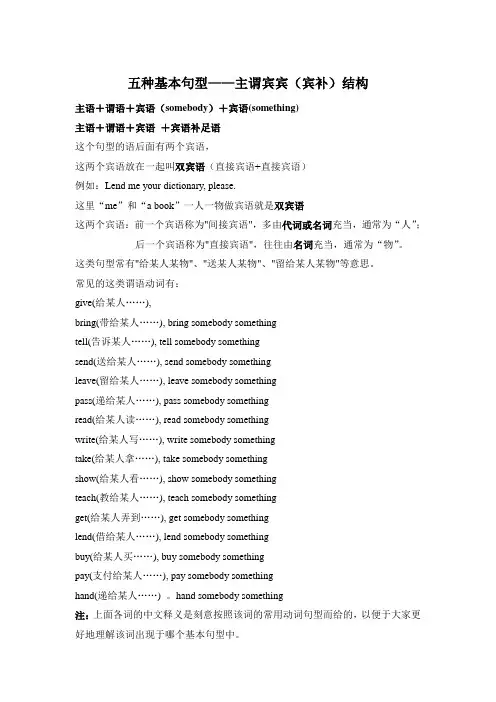
五种基本句型——主谓宾宾(宾补)结构主语+谓语+宾语(somebody)+宾语(something)主语+谓语+宾语+宾语补足语这个句型的语后面有两个宾语,这两个宾语放在一起叫双宾语(直接宾语+直接宾语)例如:Lend me your dictionary, please.这里“me”和“a book”一人一物做宾语就是双宾语这两个宾语:前一个宾语称为"间接宾语",多由代词或名词充当,通常为“人”;后一个宾语称为"直接宾语",往往由名词充当,通常为“物”。
这类句型常有"给某人某物"、"送某人某物"、"留给某人某物"等意思。
常见的这类谓语动词有:give(给某人……),bring(带给某人……), bring somebody somethingtell(告诉某人……), tell somebody somethingsend(送给某人……), send somebody somethingleave(留给某人……), leave somebody somethingpass(递给某人……), pass somebody somethingread(给某人读……), read somebody somethingwrite(给某人写……), write somebody somethingtake(给某人拿……), take somebody somethingshow(给某人看……), show somebody somethingteach(教给某人……), teach somebody somethingget(给某人弄到……), get somebody somethinglend(借给某人……), lend somebody somethingbuy(给某人买……), buy somebody somethingpay(支付给某人……), pay somebody somethinghand(递给某人……) 。
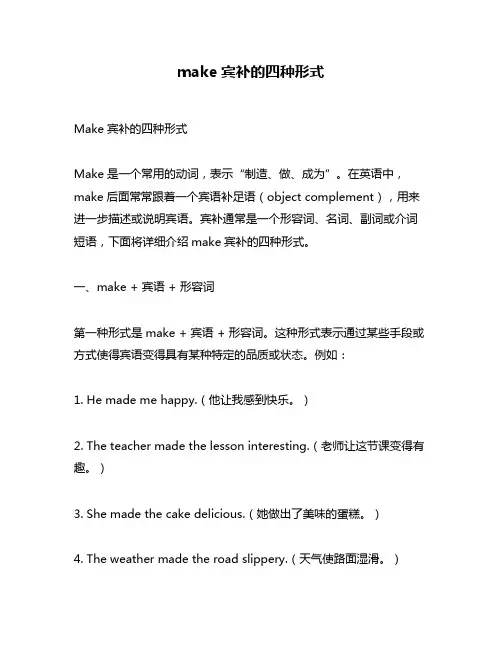
make宾补的四种形式Make宾补的四种形式Make是一个常用的动词,表示“制造、做、成为”。
在英语中,make后面常常跟着一个宾语补足语(object complement),用来进一步描述或说明宾语。
宾补通常是一个形容词、名词、副词或介词短语,下面将详细介绍make宾补的四种形式。
一、make + 宾语 + 形容词第一种形式是make + 宾语 + 形容词。
这种形式表示通过某些手段或方式使得宾语变得具有某种特定的品质或状态。
例如:1. He made me happy.(他让我感到快乐。
)2. The teacher made the lesson interesting.(老师让这节课变得有趣。
)3. She made the cake delicious.(她做出了美味的蛋糕。
)4. The weather made the road slippery.(天气使路面湿滑。
)二、make + 宾语 + 名词第二种形式是make + 宾语 + 名词。
这种形式表示通过某些手段或方式使得宾语成为某种事物或物品。
例如:1. He made a decision to quit his job.(他决定辞职了。
)2. She made a dress for her daughter's birthday party.(她为女儿的生日派对做了一件裙子。
)3. They made a mistake in the calculation.(他们在计算中犯了一个错误。
)4. The company made a profit last year.(公司去年盈利了。
)三、make + 宾语 + 副词第三种形式是make + 宾语 + 副词。
这种形式表示通过某些手段或方式使得宾语变得更加强烈或明显。
例如:1. He made the music louder.(他把音乐开大了。
)2. She made the room brighter by adding more lamps.(她通过增加更多的灯光让房间更亮了。

初中英语动词及动词考点1动词的基本框架动词包括实义动词、系动词、助动词和情态动词。
(一)实义动词实义动词是能独立作谓语的动词。
按其句法功能可分为及物动词和不及物动词;按其持续性可分为延续性动词和非延续性动词。
1.及物动词:及物动词本身意义不完整,需要接宾语才能使其意思完整。
(1)动词+宾语I like this book very much.我非常喜欢这本书。
(2)动词+宾语+宾补We call the bird Polly.我们叫这只鸟Polly。
I saw the children play in the park yesterday.昨天我看见孩子们在公园玩。
注意:用省略to的不定式或现在分词作宾补的动词有:have,see,watch,notice,hear等。
(3)动词+间接宾语+直接宾语Please pass me the salt.请把盐递给我。
常见的带双宾语的动词有:give,bring,buy,get,leave,lend,make,offer,pass,teach,tell等。
2.不及物动词不及物动词自身意思完整,不用接宾语。
Horses run fast.马跑得快。
(1)有些动词既可作及物动词又可作不及物动词。
We study English.我们学习英语。
(及物动词)We study hard.我们努力学习。
(不及物动词)(2)有些不及物动词与一些别的词搭配在一起构成动词短语,它的作用相当于一个及物动词。
①动词+介词Listen to the teacher carefully.仔细听老师讲。
此类动词短语后面的宾语无论是名词还是代词,都只能放在介词后面,不能放在动词和介词之间。
②动词+副词+介词Let’s go on with our work!让我们继续我们的工作吧!He gets along well with his classmates.他与他的同学们相处得很好。
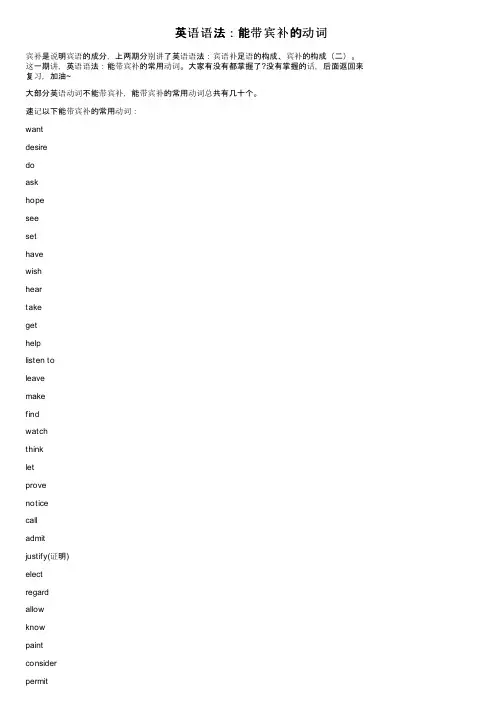
英语语法:能带宾补的动词宾补是说明宾语的成分,上两期分别讲了英语语法:宾语补足语的构成、宾补的构成(二)。
这一期讲,英语语法:能带宾补的常用动词。
大家有没有都掌握了?没有掌握的话,后面返回来复习,加油~大部分英语动词不能带宾补,能带宾补的常用动词总共有几十个。
速记以下能带宾补的常用动词:wantdesiredoaskhopeseesethavewishheartakegethelplisten toleavemakefindwatchthinkletprovenoticecalladmitjustify(证明)electregardallowknowpaintconsiderpermitputturnnamedeem(认为)keepstartsendthrowgivelockdye(染)persuade(说服)expectinvitepushcutholdlikeorderjudgedrive(逼迫)pat(轻拍)wipeknockpickbelievedeclare(宣称)例如:They want it doneright now.他们现在就要它完成。
I heard a boy crying for tenminutes.我听到一个男孩哭了半小时。
I want you to follow me.我想你跟着我。
错误聚焦——容易被误作为宾补的词语主要是一些原形动词,例如:谁要你走?×Who wants you go?√Who wants you togo? (改成动词不定式)我要他过来。
×I will ask them come.√I will ask them to come. (改成动词不定式)。
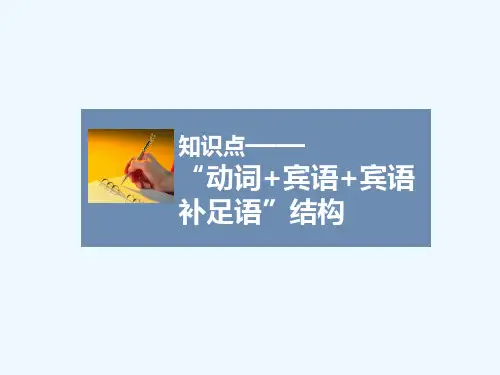
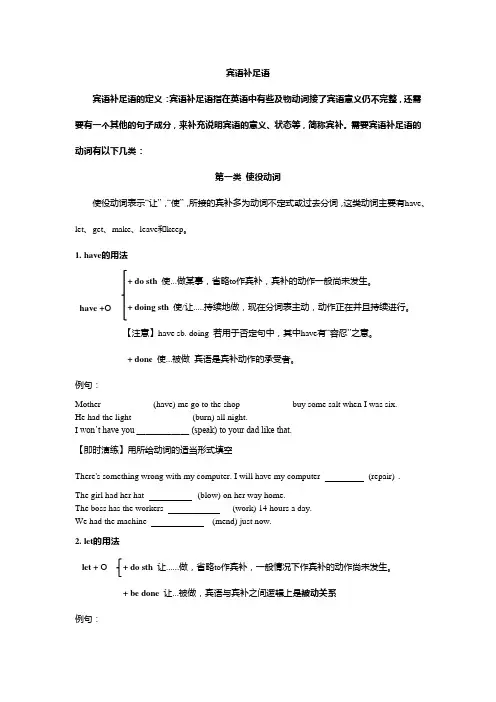
宾语补足语宾语补足语的定义:宾语补足语指在英语中有些及物动词接了宾语意义仍不完整,还需要有一个其他的句子成分,来补充说明宾语的意义、状态等,简称宾补。
需要宾语补足语的动词有以下几类:第一类 使役动词使役动词表示“让”,“使”,所接的宾补多为动词不定式或过去分词,这类动词主要有have 、let 、get 、make 、leave 和keep 。
1. have 的用法 使...做某事,省略to 作宾补,宾补的动作一般尚未发生。
使/让.....持续地做,现在分词表主动,动作正在并且持续进行。
【注意】have sb. doing 若用于否定句中,其中have 有“容忍”之意。
+ done 使...被做 宾语是宾补动作的承受者。
例句:Mother ___________ (have) me go to the shop ___________ buy some salt when I was six. He had the light _____________ (burn) all night.I won’t have you ____________ (speak) to your dad like that.【即时演练】用所给动词的适当形式填空There's something wrong with my computer. I will have my computer (repair). The girl had her hat (blow) on her way home.The boss has the workers (work) 14 hours a day.We had the machine (mend) just now.2. let 的用法让......做,省略to 作宾补,一般情况下作宾补的动作尚未发生。
+ be done 让...被做,宾语与宾补之间逻辑上是被动关系例句:have +Olet + ODon’t let your child play with matches. 别让你的孩子玩火柴。
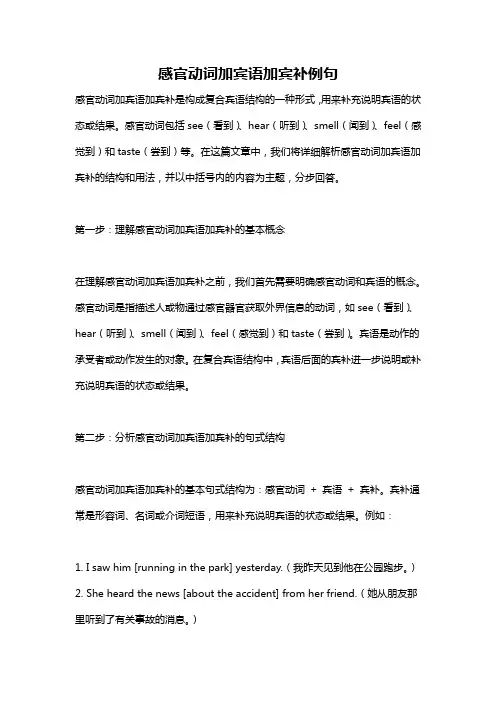
感官动词加宾语加宾补例句感官动词加宾语加宾补是构成复合宾语结构的一种形式,用来补充说明宾语的状态或结果。
感官动词包括see(看到)、hear(听到)、smell(闻到)、feel(感觉到)和taste(尝到)等。
在这篇文章中,我们将详细解析感官动词加宾语加宾补的结构和用法,并以中括号内的内容为主题,分步回答。
第一步:理解感官动词加宾语加宾补的基本概念在理解感官动词加宾语加宾补之前,我们首先需要明确感官动词和宾语的概念。
感官动词是指描述人或物通过感官器官获取外界信息的动词,如see(看到)、hear(听到)、smell(闻到)、feel(感觉到)和taste(尝到)。
宾语是动作的承受者或动作发生的对象。
在复合宾语结构中,宾语后面的宾补进一步说明或补充说明宾语的状态或结果。
第二步:分析感官动词加宾语加宾补的句式结构感官动词加宾语加宾补的基本句式结构为:感官动词+ 宾语+ 宾补。
宾补通常是形容词、名词或介词短语,用来补充说明宾语的状态或结果。
例如:1. I saw him [running in the park] yesterday.(我昨天见到他在公园跑步。
)2. She heard the news [about the accident] from her friend.(她从朋友那里听到了有关事故的消息。
)3. He smelled something [burning] in the kitchen.(他闻到厨房里有一股燃烧的味道。
)4. We felt the table [shake] during the earthquake.(在地震期间,我们感觉到桌子在摇晃。
)5. The chef tasted the soup [for seasoning] before serving it.(厨师上菜之前尝了一口汤水以调味。
)以上例句中,方括号内的内容即为宾补,用来详细描述宾语的状态或结果。
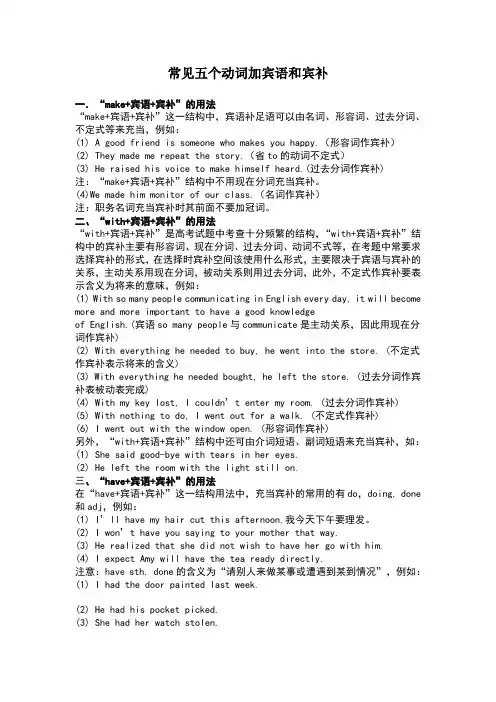
常见五个动词加宾语和宾补一.“make+宾语+宾补”的用法“make+宾语+宾补”这一结构中,宾语补足语可以由名词、形容词、过去分词、不定式等来充当,例如:(1) A good friend is someone who makes you happy.(形容词作宾补)(2) They made me repeat the story.(省to的动词不定式)(3) He raised his voice to make himself heard.(过去分词作宾补)注:“make+宾语+宾补”结构中不用现在分词充当宾补。
(4)We made him monitor of our class.(名词作宾补)注:职务名词充当宾补时其前面不要加冠词。
二、“with+宾语+宾补”的用法“with+宾语+宾补”是高考试题中考查十分频繁的结构,“with+宾语+宾补”结构中的宾补主要有形容词、现在分词、过去分词、动词不式等,在考题中常要求选择宾补的形式,在选择时宾补空间该使用什么形式,主要限决于宾语与宾补的关系,主动关系用现在分词,被动关系则用过去分词,此外,不定式作宾补要表示含义为将来的意味,例如:(1) With so many people communicating in English every day, it will become more and more important to have a good knowledgeof English.(宾语so many people与communicate是主动关系,因此用现在分词作宾补)(2) With everything he needed to buy, he went into the store. (不定式作宾补表示将来的含义)(3) With everything he needed bought, he left the store. (过去分词作宾补表被动表完成)(4) With my key lost, I couldn’t enter my room. (过去分词作宾补)(5) With nothing to do, I went out for a walk. (不定式作宾补)(6) I went out with the window open. (形容词作宾补)另外,“with+宾语+宾补”结构中还可由介词短语、副词短语来充当宾补,如:(1) She said good-bye with tears in her eyes.(2) He left the room with the light still on.三、“have+宾语+宾补”的用法在“have+宾语+宾补”这一结构用法中,充当宾补的常用的有do,doing, done 和adj,例如:(1) I’ll have my hair cut this afternoon.我今天下午要理发。
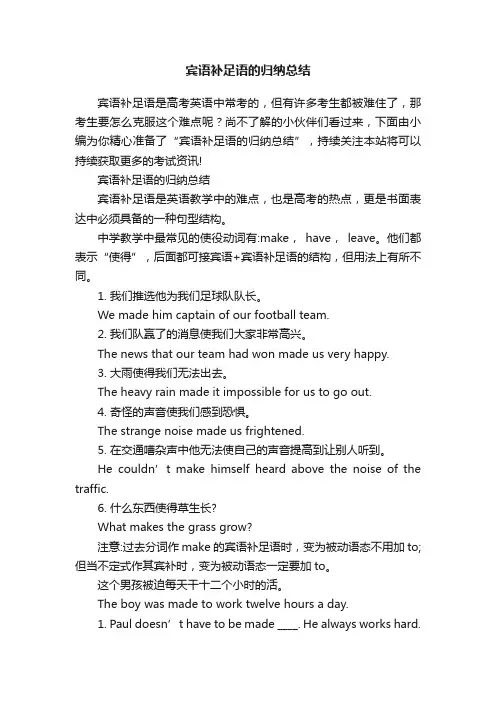
宾语补足语的归纳总结宾语补足语是高考英语中常考的,但有许多考生都被难住了,那考生要怎么克服这个难点呢?尚不了解的小伙伴们看过来,下面由小编为你精心准备了“宾语补足语的归纳总结”,持续关注本站将可以持续获取更多的考试资讯!宾语补足语的归纳总结宾语补足语是英语教学中的难点,也是高考的热点,更是书面表达中必须具备的一种句型结构。
中学教学中最常见的使役动词有:make,have,leave。
他们都表示“使得”,后面都可接宾语+宾语补足语的结构,但用法上有所不同。
1. 我们推选他为我们足球队队长。
We made him captain of our football team.2. 我们队赢了的消息使我们大家非常高兴。
The news that our team had won made us very happy.3. 大雨使得我们无法出去。
The heavy rain made it impossible for us to go out.4. 奇怪的声音使我们感到恐惧。
The strange noise made us frightened.5. 在交通嘈杂声中他无法使自己的声音提高到让别人听到。
He couldn’t make himself heard above the noise of the traffic.6. 什么东西使得草生长?What makes the grass grow?注意:过去分词作make的宾语补足语时,变为被动语态不用加to; 但当不定式作其宾补时,变为被动语态一定要加to。
这个男孩被迫每天干十二个小时的活。
The boy was made to work twelve hours a day.1. Paul doesn’t have to be made ____. He always works hard.A. learnB. to learnC. learnedD. learning2. The result of the entrance exams was not made ____ to the public until last Thursday.A. knowingB. knownC. to knowD. to be known答案:1.B2.Bhave sb. do sth.使得某人做某事have sb. doing sth.使得某人一直做某事have sth. done使得某事被做1. The teacher had her ____(recite) the text again.2. He wants to have his eyes ____(examine) tomorrow.3. Be careful, or you’ll have your hands ____(hurt).4. He had the girl ____(stand) in the classroom the whole morning.5. He had the walls ____(paint) this morning.答案:1.recite 2.examined 3.hurt 4.standing 5.painted只能用doing的情况1. 表示正在发生Be quick. They have the car waiting for you at the school gate.2. 否定句中表示(不能)容忍某人做……Iwon’t have him cheating in the exam.3. 表示某一时间内一直延续不断的动作He had us laughing all through the meals.1. I’ve had my radio ____ so soon because my father had me ____ it. A. repair; done B. repaired; do C. repairing; do D. repaired; done2. You can’t have the horse ____ all the way. It’s too hot.A. runB. to runC. runningD. to be running3. Mrs. Brown was much disappointed to see the washing machine she had had ____ went wrong again.A. itB. it repairedC. repairedD. to be repaired4. We will have you ____(know) that the machine has been made ____(work) at full speed.答案:1.B 2.C 3.C 4.know, to work1. 用形容词作宾语补足语出去时,不要关门。
常见五个动词加宾语和宾补一.“make+宾语+宾补”的用法“make+宾语+宾补”这一结构中,宾语补足语可以由名词、形容词、过去分词、不定式等来充当,例如:(1) A good friend is someone who makes you happy.(形容词作宾补)(2) They made me repeat the story.(省to的动词不定式)(3) He raised his voice to make himself heard.(过去分词作宾补)注:“make+宾语+宾补”结构中不用现在分词充当宾补。
(4)We made him monitor of our class.(名词作宾补)注:职务名词充当宾补时其前面不要加冠词。
二、“with+宾语+宾补”的用法“with+宾语+宾补”是高考试题中考查十分频繁的结构,“with+宾语+宾补”结构中的宾补主要有形容词、现在分词、过去分词、动词不式等,在考题中常要求选择宾补的形式,在选择时宾补空间该使用什么形式,主要限决于宾语与宾补的关系,主动关系用现在分词,被动关系则用过去分词,此外,不定式作宾补要表示含义为将来的意味,例如:(1) With so many people communicating in English every day, it will become more and more important to have a good knowledgeof English.(宾语so many people与communicate是主动关系,因此用现在分词作宾补)(2) With everything he needed to buy, he went into the store. (不定式作宾补表示将来的含义)(3) With everything he needed bought, he left the store. (过去分词作宾补表被动表完成)(4) With my key lost, I couldn’t enter my room. (过去分词作宾补)(5) With nothing to do, I went out for a walk. (不定式作宾补)(6) I went out with the window open. (形容词作宾补)另外,“with+宾语+宾补”结构中还可由介词短语、副词短语来充当宾补,如:(1) She said good-bye with tears in her eyes.(2) He left the room with the light still on.三、“have+宾语+宾补”的用法在“have+宾语+宾补”这一结构用法中,充当宾补的常用的有do,doing, done 和adj,例如:(1) I’ll have my hair cut this afternoon.我今天下午要理发。
常跟复合宾语的动词有:call (叫),named (叫做),make (做),think (思考),find (找),leave (离开),keep (保持),nominate (任命),choose , elect (选举),define (定义),regard (认为),see (看),recognize (认出),treat,take,consider(考虑),look up,refer to (提至U),accept (接受),ack no wledge (承认),describe ,depict (描述),represent (表现出),declare (宣称),denounce (指责),employ (雇佣),use (使用),show (展示),organize , express (表达)等。
接不定式作宾补的36个常用动词advise sb. to do sth. 建议某人做某事allow sb. to do sth. 允许某人做某事request sb. to do sth. 要求某人做某事remi nd sb. to do sth. 提醒某人做某事teach sb. to do sth .教某人做某事tell sb. to do sth. 告诉某人做某事train sb. to do sth. 训练某人做某事trouble sb. to do sth. 麻烦某人做某事wa nt sb. to do sth. 想要某人做某事warn sb. to do sth. 警告某人做某事wish sb. to do sth. 希望某人做某事汉语的"原谅某人做某事”,英语可说成excuse [forgive] sb. for doi ng sth.不带to的不定式作宾补动词不定式在使役动词( make , let, have )或感官动词(feel , listen to , hear, look at , see , watch , notice )之后作宾补时不定式需省去to。
五种【2 】根本句型——主谓宾宾(宾补)构造主语+谓语+宾语(somebody)+宾语(something)主语+谓语+宾语+宾语补足语这个句型的语后面有两个宾语,这两个宾语放在一路叫双宾语(直接宾语+直接宾语)例如:Lend me your dictionary, please.这里“me”和“a book”一人一物做宾语就是双宾语这两个宾语:前一个宾语称为"间接宾语",多由代词或名词充当,平日为“人”;后一个宾语称为"直接宾语",往往由名词充当,平日为“物”.这类句型常有"给或人某物"."送或人某物"."留给或人某物"等意思.常见的这类谓语动词有:give(给或人……),bring(带给或人……), bring somebody somethingtell(告知或人……), tell somebody somethingsend(送给或人……), send somebody somethingleave(留给或人……), leave somebody somethingpass(递给或人……), pass somebody somethingread(给或人读……), read somebody somethingwrite(给或人写……), write somebody somethingtake(给或人拿……), take somebody somethingshow(给或人看……), show somebody somethingteach(教给或人……), teach somebody somethingget(给或人弄到……), get somebody somethinglend(借给或人……), lend somebody somethingbuy(给或人买……), buy somebody somethingpay(付出给或人……), pay somebody somethinghand(递给或人……) .hand somebody something注:上面各词的中文释义是锐意按照该词的常用动词句型而给的,以便于大家更好地懂得该词消失于哪个根本句型中.例如:She brought me a shirt .她给我带来一件衬衣.Pass him the dictionary, please.请将词典递给他.I lend him my bicycle.我把自行车借给他了.五种根本句型之主语+谓语+宾语+宾语补足语语法书上又叫做主语+谓语+复合宾语,这里的复合宾语=宾语+宾语补足语, 宾语补足语:例子:ask somebody to do something (邀请或人做某事)tell somebody to do something (告知或人做某事)want somebody to do something (请求或人做某事)1. I asked him to have dinner.谓语宾语宾语补足语2. He told me to clean the room.谓语宾语宾语补足语3. Tom wanted me to meet him .谓语宾语宾语补足语第一个句子,我邀请他吃饭,他(him)是作邀请(asked)的宾语,假如后面没有to have dinner ,句子意思就不完全,我邀请他,干什么呢?没说清晰,于是就有to have dinner来关心说清晰,是吃饭的,在这里的to have dinner 就是宾语补足语,这是动词不定式短语作宾补.to do 是动词不定式,但是假如动词不定式中的动词带有宾语或者动词不定式中的动词有副词来润饰,这时的动词不定式就成为不定式短语了.比如to do something 就是动词不定式短语,换句话说:这里 to have(动词不定式) to have dinner(动词不定式短语).又比如:to run是动词不定式to run fast 是动词不定式短语).上面的三个句子都是不定式短语作宾语不足语来关心宾语来补充解释.常见宾补的类型:doing \不带to的动词不定式\介词短语\形容词等等.请看下面的例句,留意不雅察划线的部分是有什么作的宾语补足语.:1.I saw a thief stealing something. 我看到一个贼正在偷器械2.He made me go home他让我回家3.Her mother kept her in the room . 她的妈妈让她待在房间里此句型的症结是记住那些动词后面是跟什么样的宾补.比如:我们可以说 ask somebody to do something (to do something 作宾补)我们就不能说 ask somebody doing something下面记住动词后面跟什么样的宾补口诀:1.动词后面是跟带to的动词不定式(动词不定式可以分为带to的动词不定式和不带to的不定式两种,不带to的不定式现实上就是动词本相)作宾补的order somebody to do somethingwant somebody to do somethingtell somebody to do somethinginvite somebody to do somethingask somebody to do somethingbeg somebody to do something(留意上面的有六个单词可以跟动词不定式作宾补,我们可以按照语气的强弱来记忆这几个单词:敕令>请求>告知>邀请>请求>乞求)此外,还有 advise somebody to do somethingallow somebody to do somethingwarn somebody to do somethingteach somebody to do something2. 动词后面可以跟不带to的动词不定式作宾补的口决:一感二听三让五看半关心这里:一感(feel)二听(hear\listen to )三让(let \make\have)五看(see\watch\notice\observe\look at)半关心(help).即: feel hear listen to let make leave somebody do sth see watch notice observe look at help4. 动词后面是跟doing作宾补的,可以借助上面的句子来记忆,上面的单词中除了三让(have\let\make)半关心(help)不能跟dong作宾补之外,其它都是可以的.(即:一感二听五看,现实上它们都属于感官动词)演习四一断定下列句子是主谓+双宾语构造照样主谓+复合宾语,假如是主谓+复合宾语,请指出复合宾语是由什么充当的.1. I watch the boy playing foot ball.2. My good friend told me a story3. Tom lent me a pencil.4. LiLi noticed two dogs fight .5. I looked at her flying a kite .6. Please hand me the paper .7. The lion ordered the hen to give him some eggs.8. He wanted you to go with him.9. Lu Yang told the little boy to go home.10. She asks me to help her . 11. My parents leave me some money .12. Lucy leads me a pencil . 13. Mother got me some tea .14. LiLei found 100 yuan in the room. 15. He showed me her photos .16. The fans made Lin Junjie a famous star.17. Mom let me in. 18. The rich man bought his son an MP4.19. The teacher observes the boy sleep. 20. The teacher made her monitor.21. I saw the baby cry. 22. I paid him three yuan .23. He passed me an eraser. 24. Lucy heard her neighbor singing25. Tom teaches us English. 26. They asked the teacher to explain it again .27. Let me read you his letter . 28. Would you sing us an English song ?29. I will lend you something. 30. Did you notice me leave the house演习四答案1. I watch the boy playing foot ball.我看到谁人男孩在踢足球.主谓+宾语+宾补.playing foot ball做宾补2. My good friend told me a story我的好同伙给我讲了一个故事.主谓+双宾3. Tom lent me a pencil.汤姆借给我一个铅笔.主谓+双宾4. LiLi noticed two dogs fight.李利留意到两个狗在打架.主谓+宾语+宾补,fight做宾补5. I looked at her flying a kite.我看到她在放风筝.主谓+宾语+宾补.flying a kite做宾补6. Please hand me the paper .请递给我一张纸.主谓+双宾7. The lion ordered the hen to give him some eggs.那头狮子敕令那只母鸡给他一些鸡蛋.主谓+宾语+宾补.to give him some eggs做宾补8. He wanted you to go with him.他要你一路跟他去.主谓+宾语+宾补.to go with him做宾补9. Li Yang told the little boy to go home.李扬叫谁人小男孩回家.主谓+宾语+宾补.to go home做宾补10. She asks me to help her .她请我去关心她.主谓+宾语+宾补.to help her做宾补11. My parents leave me some money .我的怙恃亲留给我一些钱.主谓+双宾12. Tom leads me a pencil .汤姆借给我一只铅笔.主谓+双宾13. Mother got me some tea .妈妈给我取了一些茶.主谓+双宾14. LiLei found 100 yuan in the room.李蕾发明有100元在房间里/李蕾在房间里发明了100元.主谓+宾语+宾补.in the room做宾补15. He showed me her photos .他让我看了看她的照片.主谓+双宾16. The fans made Lin Junjie a famous star.那些粉丝们让林俊杰成为一个明星.主谓+双宾17. Mom let me in.妈妈让我进去.主谓+宾语+宾补.in做宾补18. The rich man bought his son an MP4.谁人有钱人给他的儿子买了一个MP4.主谓+双宾19. The teacher observes the boy sleep.谁人先生不雅察到谁人男孩睡觉了.主谓+宾语+宾补.sleep做宾补20. The teacher made her monitor.先生让她做班长.主谓+双宾21. I saw the baby cry.我看到谁人男孩哭了.主谓+宾语+宾补.cry做宾补22. I paid him three yuan .我付给他三元.主谓+双宾23. He passed me an eraser.他递给我一个橡皮.主谓+双宾24. She heard her neighbor singing她听到她的邻人在唱歌.主谓+宾语+宾补.singing做宾补25. Tom teaches us English.汤姆教我们英语.主谓+双宾26. They asked the teacher to explain it again .他们请先生在解释一遍.主谓+宾语+宾补.to explain it again做宾补27. Let me read you his letter .让我给你读读他的信.主谓+双宾28. Would you sing us an English song ?你可以给我们唱支英文歌吗?主谓+双宾29. I will lend you a book .我将借给你`一本书.主谓+双宾30. Did you notice me leave the house?你留意到我分开房子吗?主谓+双宾。
用作宾补的几种常见形式■崔长平河南遂平一高(463100)中学教材中经常出现一些复合宾语结构,含有复合宾语的句型为:主语(s)+及物动词(vt。
)+宾语(o)+宾补(o。
c)能充当宾补的形式有:1.名词If anyone came to set me free, I would make him king over the world.In 1849, he went to England and made London the base for his revolutionary work。
说明:1)常用名词作宾语的动词有:find, make,elect,name,call,consider,think,choose 等。
2)表示职位、官衔的名词作宾补时,其前不用冠词或用定冠词总是暗指正职,如用不定冠词,表示该职位或官衔不是唯一的,暗指副职。
2.形容词或副词The guard brought out his knife and cut one boot open。
I made a promise that if anyone set me free, I would make him very rich.Very loud noise can make people ill, hurt their ears, or even drive them mad.说明:1)常接形容词或副词作宾补的动词有:believe,cut,consider,think, prove,get, make, drive,want,keep,turn,set,find,wish,wash,leave 等。
2)当宾语是不定式或从句时,用it 作形式宾语,并将不定式或从句移到宾补的后边.They want to make it clear to the public that they do an important and necessary job.He found it important to study the situation in Russia.3. 不定式(短语)She wanted him to sing for her friends.Nothing could make me turn against my country.He ordered a soldier to bring a national flag and covered the boy’s body with it, leaving his face exposed 。
一、“make+宾语+xx”的用法“make+宾语+宾补”这一结构中,宾语补足语可以由名词、形容词、过去分词、不定式等来充当,例如:(1) A good friend is someone who makes you happy.(形容词作宾补)(2) They made me repeat the story.(省to的动词不定式)(3) He raised his voice to make himself heard.(过去分词作宾补)注:“make+宾语+宾补”结构中不用现在分词充当宾补。
(4)We made him monitor of our class.(名词作宾补)注:职务名词充当xx补时其前面不要加冠词。
【试题链接】1. He is very popular among his students as he always tries to make them___ in his lectures.A.interestedB.interestingC.interestD.to interest2.Myparentshavealwaysmademe___aboutmyself,evenwhenIwastwelve.A.feeling wellB.feeling goodC.feel wellD.feel good答案:1.A2.D二、“with+宾语+xx”的用法“with+宾语+宾补”是高考试题中考查十分频繁的结构,“with+宾语+宾补”结构中的宾补主要有形容词、现在分词、过去分词、动词不定式等,在考题中常要求选择宾补的形式,在选择时宾补空间该使用什么形式,主要限决于宾语与宾补的关系,主动关系用现在分词,被动关系则用过去分词,此外,不定式作宾补要表示含义为将来的意味,例如:(2) With everything he need to buy, he went into the store. (不定式作宾补表示将来的含义)(3) With everything he need bought, he left the store. (过去分词作宾补表被动表完成)(4) With my key lost, I couldn’t enter my room. (过去分词作宾补)(5) With nothing to do, I went out for a walk. (不定式作宾补)(6) I went out with the window open. (形容词作宾补)另外,“with+宾语+宾补”结构中还可由介词短语、副词短语来充当宾补,如:(1) She said good-bye with tears in her eyes.(2) He left the room with the light still on.【试题链接】1. ----Come on, please give me some ideas about the project.----Sorry. With so much work ___ my mind, I almost break down.A.filledB.fillingC.to fillD.being filled2. John received an invitation to dinner, and with his work ___ hegladly accepted it.A.finishedB.finishingC.having finishedD.was finished3. I couldn’t to my homework with all the noise___.A.going onB.goes onC.went onD.to go on答案:1. B2. A3. A三、“have+宾语+xx”的用法在“have+宾语+宾补”这一结构用法中,充当宾补的常用的有do,doing,done 和adj,例如:(1) I’ll have my hair cut this afternoon.我今天下午要理发。
(2) I won’t have you saying to your mother that way.(3) He realized that she did not wish to have her go with him.(4) I expect Amy will have the tea ready directly.注意:have sth. done的含义为“请别人来做某事或遭遇到某到情况”,例如:(1) I had the door painted last week.(2) He had his pocket picked.(3) She had her watch stolen.【试题链接】1.JennyhopesthatMr.SmithwillsuggestagoodwaytohaveherwrittenEnglish ___ ina short period.A.improvedB.improvingC.to improveD.improveA.has it fixedB.had fixed itC.had it fixedD.fixed it3. You should understand the traffic rule by now. You’ve had it ___often enough.A.explaingB.to explainC.explainD.explained答案:1. A2. C3. D四、“find+宾语+xx”的用法“find+宾语+宾补”这一结构中的宾语补足语可以由现在分词、过去分词、名词、形容词、副词、介词短语以及不定式to be等来充当。
分别举例如下:(1) You will find it a very difficult book.(2) The youth found it a hard problem to think about.(3) When he came to himself, he found himself surrounded by a group ofboys.(4) I hope to find you in better spirits when we meet again.(5) I find the Chinese people to be happy and cheerful.注意:find+宾语+宾补这一结构中通常不使用动词原形来充当宾语补足语,即没有“find+宾语+动词原形”这样的结构。
【试题链接】A cook will be immediately fired if he is found __ in the kitchen.(03全国卷)A.smokeB.smokingC.to smokeD.smoked答案:B。
五、“leave+宾语+xx”的用法Leave+宾语+宾语补足语,其中宾语补足这一成分可以由过去分词、现在分词、形容词、介词的复合结构等来充当,分述如下:1.由过去分词来充当宾语补足语:leavesth/sbdone,常用来表示宾语所处的状态或表示动作已经完成。
(1) Please excuse me if I have left any of your questions unanswered.(2) He got up slowly leaving the lunch unfinished.(3) Did you leave the doors and windows firmly fastened?△可用于被动语态:Hi!My patient can’t be left unattached.2.由现在分词来充当宾语补足语:leavesb/sthdoing,常用来表示使某人或某物一直做某事:(1) Don’t leave her waiting outside in the rain.(2) They went off together and left me sitting there.(3) We left him painting the gate.△可用于被动语态:Now the temple has only its walls left standing.The papers were left lying around.3.由形容词来充当宾语补足语:(1) You’d better leave the drawing-room door open.(2) His illness has left him weak.△可用于被动语态:The window was left open.4.由介词的复合结构充当宾语补足语:(1) Leave him in peace!(2) His illness left him with a weak heart.(3) You’ve left her name off the list.△可用于被动语态:I was left without a ray of hope.【试题链接】A good story does not necessarily have to have a happy ending, but thereader must not be left___.A.unsatisfiedB.unsatisfyingC.tobeunsatisfyingD.beingunsatisfied答案:A六、“hear+宾语+xx”的用法“hear+宾语+宾补”这一结构中的宾补常可以由现在分词、不带to的不定式、过去分词等来充当,如:Through the wall he could hear Harris cleaning his teeth.She could hear the rain pattering against the windows.Have you ever heard a pop song sung in Japanese?I won’t hear anything said against him behind his back.【试题链接】Afteraknockatthedoor,thechildheardhismother’svoice___him.A.callingB.calledC.being calledD.to call答案:A。